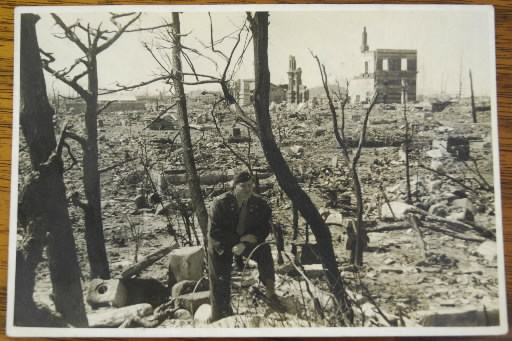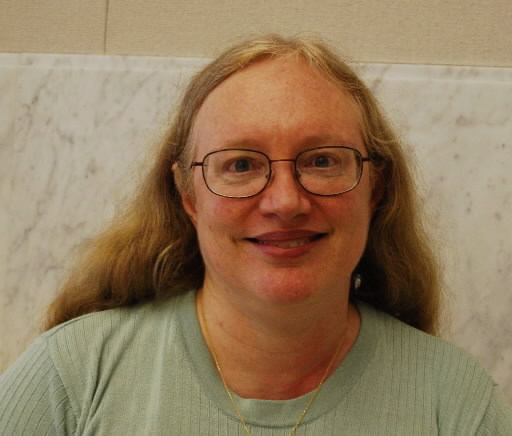Daughter of U.S. photographer provides Hiroshima Peace Memorial Museum with 210 A-bomb photographs
Jul. 13, 2009
by Miho Kuwajima, Staff Writer
On July 10, Leslie Sussan, 56, a resident of the U.S. state of Maryland, provided Hiroshima Peace Memorial Museum with 210 photographs she had inherited from her father. As a photographer attached to the U.S. Strategic Bombing Survey, her father, Herbert Sussan (1922-1985), took the photos in Hiroshima and Nagasaki six to eight months after the atomic bombings. The prints are believed to include unpublished images so the museum intends to study them in detail.
Most of the photos are thought to have been taken in Hiroshima and Nagasaki in 1946. Among the images of Hiroshima, one photo depicts Mr. Sussan standing in the vicinity of the hypocenter during his survey activity. Others show members of the survey team filming from atop a ladder truck.
Hironobu Ochiba, a curator at the museum, said, “These are valuable photographs. Some of them we’ve never seen before. We intend to study them carefully to clarify where the photos were taken and other details.”
Mr. Sussan shared little of his experience in the A-bombed cities with his family and did not let them see the photos, which were stored in a closet.
Reflecting on her father, who had strong thoughts toward Hiroshima, Leslie said, “My father seemed to fear surveillance by the government and the military about his hidden photos. In his later years, he confided to me that he had been terrified by the thought that New York City might suffer a nuclear attack, like Hiroshima. In his will, he said that he hoped his ashes could be scattered near the hypocenter in Hiroshima.”
Peace Memorial Museum will hold a gathering on July 13 at 4 p.m. where Leslie Sussan will speak about her father.
The U.S. Strategic Bombing Survey (USSBS)
The USSBS was established in November 1944 as a joint entity comprised of the U.S. army and navy. To study the effects of the atomic bombing, USSBS arrived in Japan in September 1945. Its team visited Hiroshima in March 1946, after spending time in Nagasaki. The team stayed in Hiroshima for two months. The color footage filmed by the USSBS was later purchased through a Japanese campaign called the 10 Feet Film Project.
(Originally published on July 11, 2009)
On July 10, Leslie Sussan, 56, a resident of the U.S. state of Maryland, provided Hiroshima Peace Memorial Museum with 210 photographs she had inherited from her father. As a photographer attached to the U.S. Strategic Bombing Survey, her father, Herbert Sussan (1922-1985), took the photos in Hiroshima and Nagasaki six to eight months after the atomic bombings. The prints are believed to include unpublished images so the museum intends to study them in detail.
Most of the photos are thought to have been taken in Hiroshima and Nagasaki in 1946. Among the images of Hiroshima, one photo depicts Mr. Sussan standing in the vicinity of the hypocenter during his survey activity. Others show members of the survey team filming from atop a ladder truck.
Hironobu Ochiba, a curator at the museum, said, “These are valuable photographs. Some of them we’ve never seen before. We intend to study them carefully to clarify where the photos were taken and other details.”
Mr. Sussan shared little of his experience in the A-bombed cities with his family and did not let them see the photos, which were stored in a closet.
Reflecting on her father, who had strong thoughts toward Hiroshima, Leslie said, “My father seemed to fear surveillance by the government and the military about his hidden photos. In his later years, he confided to me that he had been terrified by the thought that New York City might suffer a nuclear attack, like Hiroshima. In his will, he said that he hoped his ashes could be scattered near the hypocenter in Hiroshima.”
Peace Memorial Museum will hold a gathering on July 13 at 4 p.m. where Leslie Sussan will speak about her father.
The U.S. Strategic Bombing Survey (USSBS)
The USSBS was established in November 1944 as a joint entity comprised of the U.S. army and navy. To study the effects of the atomic bombing, USSBS arrived in Japan in September 1945. Its team visited Hiroshima in March 1946, after spending time in Nagasaki. The team stayed in Hiroshima for two months. The color footage filmed by the USSBS was later purchased through a Japanese campaign called the 10 Feet Film Project.
(Originally published on July 11, 2009)









